
|
|
|
|
|
|
Home
About
Resources
anti-aging vitamins books
- A New Approach...
- The Exodus Happened 2450 B.C.
- Noah's Flood Happened 3520 B.C.
- Age of the Earth Collection
- Aging: Cause and Cure
- Bread from Heaven: The Manna Mystery Solved
newsletters
podcast
speaker for an event
time charts
videos
Topics
Overview
Biblical Chronology Dendrochronology Radiocarbon Dating Mt. Sinai Jericho Ai The Exodus Noah's Ark Imhotep/Joseph
Correspondence
- anti-aging vitamins
- antiquity of mankind
- ark search
- Bible chronology
- "The BC" publication
- Bryant Wood's critique
- calendars
- Heshbon
- horses and chariots in Egypt
- Jericho --- Joshua's curse
- lifespan research
- missing millennium: reception
- missing millennium: textual
- Mt. Sinai
- Noah's Flood
- Philistines
- radiocarbon
- Sodom and Gomorrah
- teaching science and creation
- the Exodus
- tree rings
- virtual history
- young earth creation
Contact Us
Where is Mt. Sinai located?The following article is abstracted from The Biblical Chronologist Volume 6, Number 4. Full details and references can be found there.Mt. Yeroham - Not a Traditional ChoiceThrough the centuries many different mountains have been proposed as the biblical Mt. Sinai. A good Bible encyclopedia will list several. In 1995 Gerald E. Aardsma, Ph.D., proposed a new mountain. This proposal has since been corroborated by a convincing body of evidence.
Why Mt. Yeroham?What sets this mountain apart from the many other candidates which have been suggested? It is the only mountain which meets all of the following set of criteria required by the biblical account. 1. Distance from EgyptThe true Mt. Sinai must be located outside of Egypt, but not a great distance away. The Bible records that the Israelites arrived at Sinai 45 days after leaving Egypt. Accounting for days not spent traveling (for example, time spent in battle with the Amalekites at Rephidim), and estimating a pace of 30 miles per day, Mt. Sinai must be no more than 630 miles from Egypt. Mt. Yeroham is located approximately 150 miles from Egypt. Mt. Yeroham passes this test. 2. Not in MidianThe true Mt. Sinai must not be located in Midian, as demonstrated by several scripture passages including Numbers 10:29--30. Jabal al Lawz, a somewhat popular candidate, fails this test. See Does the Bible say Mt. Sinai is in Saudi Arabia? for more information about Mt. Sinai and Midian/Arabia. Mt. Yeroham is not located in Midian, it is located in the northern Negev, thus passing this test. 3. Room for the IsraelitesWe learn from the Bible that there was a desert wilderness in front of Mt. Sinai (Exodus 19:1-3). This wilderness must have been large enough for the entire body of Israelites to camp. About 600,000 men were present in this camp (Exodus 12:37). Allowing a ten by ten foot square for each man (room for women, children, and space between tents is included in this square), a minimum of 1,377 acres is required.
4. Presence of Pottery Shards
The plain in front of Mt. Yeroham is, in fact, littered with pottery shards, thus passing test four. This picture shows a couple of pottery fragments from the plain in front of Mt. Yeroham. 5. Adequate Water SupplyThere must be an abundant, year-round source of water near the true Mt. Sinai. Two million people require a large water supply to survive for a year in the desert. While Moses brought water from the rock at Rephidim (Exodus 17:1-7), no such arrangement was necessary at Sinai.
6. Correct Time PeriodThis is the acid test. The archaeological remains at the true Mt. Sinai must date to the time of the Exodus. Modern biblical chronology has shown that the Exodus was the cause of the collapse of the Old Kingdom in Egypt, and the Conquest was the cause of the termination of Early Bronze III in Palestine. (See A New Approach to the Chronology of Biblical History from Abraham to Samuel.) Early Bronze IV in Palestine (also called Intermediate Bronze and Middle Bronze I by various archaeologists) corresponds to the period of the Judges of Israel. The Early Bronze IV people are the Israelites. Thus Early Bronze IV pottery is Israelite pottery. The pottery found at the true Mt. Sinai should date to the end of the Old Kingdom in Egypt and the beginning of Early Bronze IV in Palestinian. In fact, the pottery found at Mt. Yeroham matches these criteria very well. Further Evidence from YerohamMt. Yeroham uniquely passes this series of tests. This strongly supports the assertion that Mt. Yeroham is, in fact, the biblical Mt. Sinai. The specific archaeological remains provide even more convincing evidence that this assertion is correct. The Bamah of Moses
The Midianite/Kenite SettlementThe Bible records that Moses' Midianite relatives, an ethnic group distinct from the Israelites, were present with the Israelites at Mt. Sinai (Numbers 10:29-32). Jethro, Moses' father-in-law, is described in Judges 1:16 as a Kenite. "Kenite" means metal smith: The term "Kenite" comes from qayin, which originally meant "metalworker, smith," as in Aram and Arabic. ... The Kenites apparently were nomadic or seminomadic clans of smiths... (Wycliffe Bible Encyclopedia)Numbers 24:21 says of the Kenites, "Your dwelling place is enduring, and your nest is set in the cliff" (NASB).
a hoard of eighteen copper ingots with low lead content was found. These suggest the existance of a metal industry...Once again, the biblical account matches very well with the archaeology at Mt. Yeroham. ConclusionIt is nearly impossible to escape the conclusion that Mt. Yeroham is the Mt. Sinai of the Bible. The close correlation between biblical description and archaeological finding is also a strong argument for the historicity of the Exodus/Conquest narrative in the Bible. The identification of the biblical Mt. Sinai is a truly significant result of Dr. Aardsma's chronology. The foregoing article was abstracted from The Biblical Chronologist Volume 6, Number 4. Full details and references can be found there. |
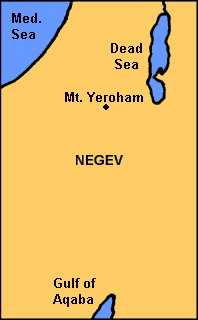 The mountain Dr. Aardsma identified is known today as Mt. Yeroham. Yeroham is located in the northern Negev, the southern desert of Israel which extends to the Gulf of Aqaba.
The mountain Dr. Aardsma identified is known today as Mt. Yeroham. Yeroham is located in the northern Negev, the southern desert of Israel which extends to the Gulf of Aqaba.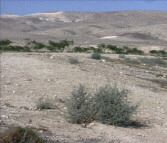 Many Mt. Sinai candidates which pass tests one and two fail this test (Jebel Musa and Jebel Katarin, for example). However there is a plain in front of Mt. Yeroham measuring more than 11,000 acres, roughly eight times the minimum size requirement. The photo at right shows part of the plain in front of Mt. Yeroham.
Many Mt. Sinai candidates which pass tests one and two fail this test (Jebel Musa and Jebel Katarin, for example). However there is a plain in front of Mt. Yeroham measuring more than 11,000 acres, roughly eight times the minimum size requirement. The photo at right shows part of the plain in front of Mt. Yeroham.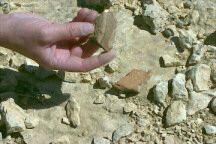 Approximately two million Israelites, counting women and children, camped at Mt. Sinai for one year.
Such a large and extended campsite necessarily results in many broken pottery pieces being left behind.
Candidates which have survived the first three tests must exhibit
an abundance of pottery shards in the wilderness in front of the mountain in order to avoid disqualification. (Of course, those candidates which don't have a suitable wilderness in front of the mountain are already disqualified.)
Approximately two million Israelites, counting women and children, camped at Mt. Sinai for one year.
Such a large and extended campsite necessarily results in many broken pottery pieces being left behind.
Candidates which have survived the first three tests must exhibit
an abundance of pottery shards in the wilderness in front of the mountain in order to avoid disqualification. (Of course, those candidates which don't have a suitable wilderness in front of the mountain are already disqualified.)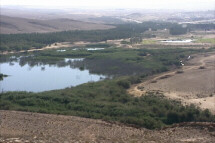 As shown in this photo, there is a large reservoir at the foot of Mt. Yeroham today. This would have been smaller at the time of the Exodus since its current size is partly due to a modern dam. The existance of this dam demonstrates that sufficient runoff is available in this area to support a reservoir. In addition to the reservoir, a well, shown on maps as "Be'er Yeroham", exists at Yeroham, and there is a modern town a few miles from the mountain. Mt. Yeroham posesses the unique feature of an abundant water supply in this desert area. Mt. Karkom, advanced as the biblical Mt. Sinai by archaeologist Emmanuel Anati fails this test.
As shown in this photo, there is a large reservoir at the foot of Mt. Yeroham today. This would have been smaller at the time of the Exodus since its current size is partly due to a modern dam. The existance of this dam demonstrates that sufficient runoff is available in this area to support a reservoir. In addition to the reservoir, a well, shown on maps as "Be'er Yeroham", exists at Yeroham, and there is a modern town a few miles from the mountain. Mt. Yeroham posesses the unique feature of an abundant water supply in this desert area. Mt. Karkom, advanced as the biblical Mt. Sinai by archaeologist Emmanuel Anati fails this test.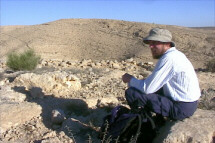 In Exodus 24:4, the Bible records that Moses "arose early in the morning, and built an altar at the foot of the mountain with twelve pillars for the twelve tribes of Israel" (NASB). There is a bamah or high place at Yeroham which suits the biblical account very well. It is located on a spur of Mt. Yeroham overlooking the plain. All that remains of it today is a rock wall surrounding the crest of the spur, and some cupmarks in the bedrock surface which outcrops within the ring of stones. The bamah wall is visible in the background of this photo of Dr. Aardsma at Mt. Yeroham. The Bamah at Mt. Yeroham lends strong support to the identification of this mountain with the biblical Mt. Sinai.
In Exodus 24:4, the Bible records that Moses "arose early in the morning, and built an altar at the foot of the mountain with twelve pillars for the twelve tribes of Israel" (NASB). There is a bamah or high place at Yeroham which suits the biblical account very well. It is located on a spur of Mt. Yeroham overlooking the plain. All that remains of it today is a rock wall surrounding the crest of the spur, and some cupmarks in the bedrock surface which outcrops within the ring of stones. The bamah wall is visible in the background of this photo of Dr. Aardsma at Mt. Yeroham. The Bamah at Mt. Yeroham lends strong support to the identification of this mountain with the biblical Mt. Sinai.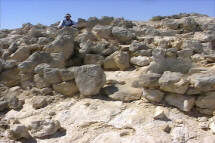 On a spur of Mt. Yeroham, the archaeologists found remains of dry-laid stone domestic structures. The photo at right shows present-day ruins of these structures. Their location and style fit well with the description of "nests...set in the cliff". They contain pottery from the correct time period, and buried in the remains of one of the dwellings, archaeologist Moshe Kochavi reports:
On a spur of Mt. Yeroham, the archaeologists found remains of dry-laid stone domestic structures. The photo at right shows present-day ruins of these structures. Their location and style fit well with the description of "nests...set in the cliff". They contain pottery from the correct time period, and buried in the remains of one of the dwellings, archaeologist Moshe Kochavi reports: